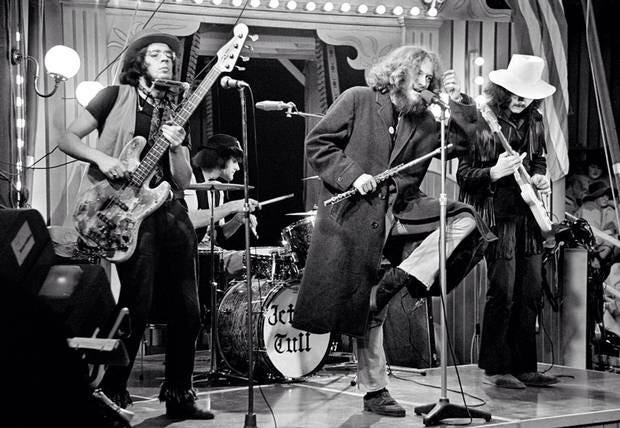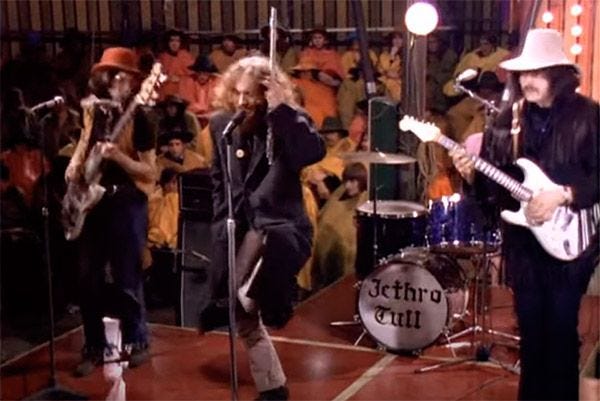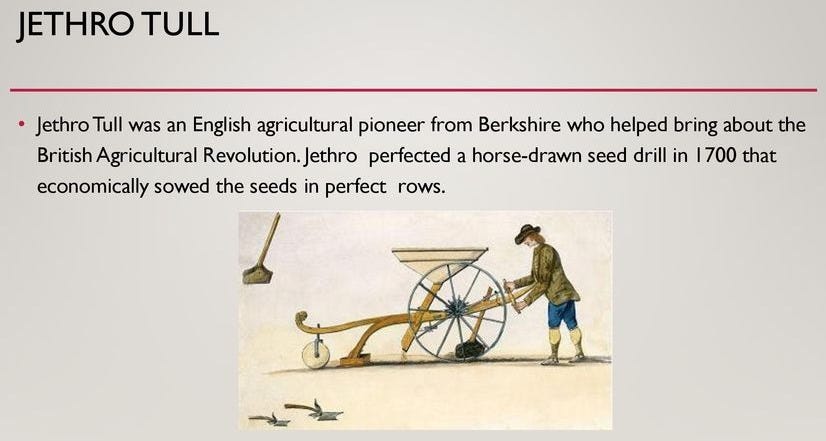UK Guitar Teacher, Tom Moloney, 25, Hears & Reacts to Jethro Tull For the First Time
A lifelong fan of the band (and a self-taught flute player) challenges a clever Gen Z guitar player to a first-hearing of several '70s-era Ian Anderson/Tull songs!


Two months before this unlikely TV-studio merging of the band who would bring us Aqualung and the left-handed guitarist who would soon provide brontosaurian riffs behind Ozzy on metal behemoths like “War Pigs,” “Sweet Leaf,” and “Paranoid,” Jethro Tull released their debut album, perplexingly called This Was:
As with all of that era’s Warner Bros. Records (and affiliates) album releases, ad-sales-exec Dad brought home this Tull promo LP from his Houston radio station. 13-year-old me thought this jacket of grizzled old men was odd and not all that “appealing,” from an immediate “hey, listen to me first” POV!
As I did with every promo Dad brought home, I gave it a dutiful listen, but wasn’t really vibing with what we now know would be the short-lived, blues-based output of what would end up not only being one of rock’s most creative “progressive” rock bands, but one of my 3 all-time faves, joining The Beatles and Genesis.
From This Was’s harmonica, front man/lead singer, Ian Anderson, leaned more and more on his self-taught flute (and eventually, saxophone) to punctuate his Tull tunes going forward, including 1969’s Stand Up, and 1970’s Benefit.
As I was lucky enough, as an adolescent, to be fully in on Tull since the release of their debut album (and self-taught myself the flute, learning by ear, all Ian’s licks off their first half-dozen albums), I found it fascinating that our guest today, a guitar-teaching UK resident in his mid-20s,
of Music’s Most Underrated, had not heard a note of Tull music!I had the pleasure of playing Tune Tag with Tom in February, and a second Tune Tag with him is certainly in the cards for later in ‘25! Get to know Tom a bit, here:
Knowing a creative challenge when I see one, I asked Tom if he’d be willing….and, he said “Yes!” So, in the style of, say, a YouTube “First Impression” or “First Time Hearing,” Tom relented to reacting to a healthy handful of late-’60s and 1970s-era Jethro Tull songs, offering his reactions and reflections of what he was hearing and seeing in the following videos!
My goal was to send them more or less chronologically, so he could see Ian Anderson’s progression as a performer, as well as Tull’s music, overall (most, if not all of it written by Anderson)! Tom wrote his reflections after each video, separately. This’ll give us a more realistic and revealing look at how Ian and his band of merrymakers affected Tom from one to another!
First song sent to Tom: “A Song for Jeffrey,” 1968:
Eventual longtime Black Sabbath guitarist, Tony Iommi, is on guitar, here. He spent 2 weeks with Tull in 1968, rehearsing for this taped (during two days in December), but un-aired BBC special, called The Rolling Stones Rock and Roll Circus (you’ll recognize Mick Jagger on the introduction…he’s the taller one)!
Tom’s initial reaction: Right off the bat, my initial impression is that Jethro Tull are the most British sounding band I have ever heard - not just in a long time, but ever!
I say this as someone from the UK, and definitely don’t say it as a bad thing. The vocals are unusual and almost sounds like the lead singer [Ian Anderson] is squeezing the sound. However, he still manages to produce a great amount of strength to his voice. The song contains excellent dynamics, particularly during the outro, as the intensity drops before suddenly rising again.
I’m very interested by the use of flute as a lead instrument. As a 25-year-old, I’m now wondering, was this common in the ‘60’s and 70’s? I very much doubt it, but maybe that is something I’ve missed. It adds an almost medieval feel to the song, like they are the local village musicians, or maybe a fairer comparison, a court jester to the kings and queens of England.
Brad steps in: Tom, the flute had become more and more of an instrument of choice in late-’60s rock, and going forward: Besides the self-taught Ian, there was Ray Thomas of The Moody Blues, Chris Wood of Traffic, and Andy Kulberg of Seatrain and The Blues Project (with their “Flute Thing” instrumental).
Peter Gabriel (above) was a sporadic player on a small handful of early-’70s Genesis songs, but his playing was fairly rudimentary, and only served as an atmospheric add-in to Steve Hackett’s ethereal playing and Tony Banks’ ever-present keyboard variety (synth, piano, mellotron). There were others like Thijs van Leer of Focus (and their “Hocus Pocus” hit in ‘73), and this Udiscovermusic.com article is a good place to start!
Back to Tom: The band are clearly very enthusiastic during this live performance and love what they are doing. Not one of the members can keep still throughout this initial clip Brad has sent me.
Song #2: “Nothing is Easy,” 1970
Tom’s initial reaction: My first thought when the singer came in to this song was, this sounds like the birth of metal. There are striking similarities to Black Sabbath in the phrasing of the vocals and the way he projects his voice.
Then there’s the guitar solo which sounds a lot more like the music of the ‘70’s that I am familiar with. However, we still have the flute playing a lead role. I don’t recall Ozzy ever pulling out a flute, and would be more shocked to see this than when I found out about his unique taste in bats. The singer takes us on a rollercoaster through the song that is only exemplified by his brilliantly manic stage presence.
Brad: Ozzy playing flute? Uh, nope. But, we did find a wacky musical marriage of an Ozzy/Blizzard of Ozz song (“Crazy Train”) with your so-smart recognition of Tull’s medieval musical veil!👇
Song #3: “The Witch’s Promise,” 1970 (UK’s Top of the Pops TV show, band synching to track)
Tom’s initial reaction: Straight away, I can feel that medieval England sound again. The vocal melodies mixed with the very upbeat and jangly guitar strums. The lead singer here is constantly moving and cannot keep himself still; it is almost as if he is possessed by the music. Then we have yet another flute solo to end the show. This has really surprised me that such a prominent band managed to use such an obscure instrument to mainstream music throughout their career.
Song #4: “Aqualung,” 1971 song performed live here, 1977
Tom’s initial reaction: This song is very progressive rock with a lot of different elements to it. There are variations to the speed of the song and it incorporates a mixture of heavily distorted sections with softer ballads. Again, this song goes back to that early metal sound, with the heavy distorted guitar, a few pinched harmonics and a lot of guitar fills between the riffs.
[Martin Barre’s] guitar solo is typical of those early classic rock songs, full of blues licks and tricks, whilst the drummer [Barriemore Barlow] effortlessly changes between double-time and standard, whilst also going hard on the symbols. [Barlow’s good friend, John Glascock, played bass here, and died two years later at 28.] The song has absolutely everything that there is in rock; heavy riffs, an acoustic section with just vocals and guitar, and an extended solo.
It really starts to make me wonder if Jethro Tull get enough credit for their innovative work fairly near the start of the Rock ‘N’ Roll era.
Song #5: “Cross-Eyed Mary,” Live, 1977
Tom’s initial response: The intro to this song is probably my favourite yet! I think it shows a progression to their sound. The writing on this song is slick and direct. They now have a sound which is working for them and they sound like a true rock band that is here for the long run.
They are still producing unique songs and creating progressive music, but with a better understanding of who they are. Whilst all of their music up to this point has been very well-performed and full of great ideas, they are now starting to put them together into a better overall piece of art.
Song #6: “Thick as a Brick” (snippets), Live, 1977
Tom’s initial reaction: So here, Brad has provided me with a little context to the song: This is an album-length song lasting around 40 minutes. However, for the video Brad sent me, it was a shortened 13-minute version they performed live in 1977. The song starts out again with the medieval English vibes I have been referring to throughout.
The layers of the song build up beautifully to increase the anticipation for the second half of the song. They use simple tricks with the subtle introduction of various instruments and slight increases in volume to constantly change the intensity. As they introduce electric instruments, the excitement within the band elevates and spreads to the listener.
This song is a truly brilliant piece of progressive rock. It has countless number of sections and so many different instruments drifting in and out as the song progresses. It’s a song that perfectly sums up Jethro Tull as you have no idea what is going to come next!
Brad: As Tull fans well know, A Passion Play followed Thick as a Brick in July 1973 (I was between my senior year in high school and my college freshman year, but I saw the concert stop in Houston). Similar to TAAB, A Passion Play was bereft of standard “songs,” and was an unbanded, straight-through “song” with different movements to allow for mood-change, etc.
I didn’t send Tom any snippets from that album, but figured he and our readers might enjoy this special half-hour doc on the album:
Song #7: “Skating Away on the Thin Ice of the New Day,” 1974, performed live, 1977
Tom’s initial reaction: The year is now 1974, and we are six years [of the band’s career] into my journey as a Jethro Tull fan. I think it is therefore fair to assume, by this point, that the band are becoming an established member of the rock music scene.
“Skating Away on the Thin Ice of the New Day” starts out as an acoustic piece, and is a relatively simple song. However, whatever Jethro Tull do, the vocals provide a uniqueness to their sound that helps it stand out. Furthermore, there are subtleties to the backing instruments and occasional effects added to the voice and guitar that make the song an interesting listen.
Due to all the band’s amazing quirks, we don’t quite know where they are going next, and this is something Jethro Tull have become so successful at. This performance perfectly demonstrates the band’s musical ability and that they aren’t just about the show: A simple acoustic song that is filled with repetition that is so common in popular music, yet still manages to keep our attention without the need for any gimmicks.
Song #8: “Minstrel in the Gallery,” 1975
Tom’s initial reaction: Similar to “Skating Away on the Thin Ice of the New Day,” “Minstrel in the Gallery” starts simply with the acoustic guitar and vocals. There is very little that is needed to be said here, just that the band still manages to hold the audience’s attention even when creating something so simple.
The introduction of the electric guitar shows Jethro Tull’s ability to compete with the very best rock bands; they can write an instrumental sections as interesting as any of the other progressive rock bands at the top of the scene. Then, we hear that flute sound again, but this time only for very short periods. It now seems that its role in the band has been reduced from the main character to a sidepiece.
Song #9: “The Whistler,” 1977 (from Songs from the Wood)
Tom’s initial reaction: “The Whistler” reminds me more of their earlier work than these last few songs Brad has sent through. It feels like a song of celebration in the medieval times. It’s as if the village is welcoming back a group of old friends and they are preparing for a feast to celebrate.
The tempo is up-paced, the guitars play with a flick in the wrist, and the drums are focusing on the high-hats and symbols to create that jangly sound in the background, as if replicating children running around playing. This song has been brilliantly written in a way which clearly sets my imagination alive. When this happens in music, it takes you outside the space around you and into the world of the writer’s mind.
Song #10: 1978’s “Heavy Horses,” performed live just shy of 40 years later (2017)!
Tom’s initial reaction: We now conclude the journey with two live performances from the 21st century! This first one is a 2017 performance of “Heavy Horses,” a duet with a young female singer from Iceland. This is a beautiful collaboration that I believe is a song anyone can appreciate.
It is perfectly emulated by the introduction, a mellow, warm-sounding section that feels like a calming voice. The vocals have aged like fine wine and the two harmonize perfectly together. The guitars and flute play melodies which flow like a fresh water river, and the pace of the song fluctuates between the vocals and instrumental sections.
Finally, “Life’s a Long Song,” from 1971, performed in 2016 in Ian’s home (son, James Duncan Anderson on drums):
Tom’s initial reaction: This may be my favourite song (or favourite performance) yet. I am a bit of a sucker for a ballad, and have an even bigger soft spot for a string section in rock songs. I’m thinking Axl Rose’s “November Rain” for his Guns N’ Roses, Diane Warren’s “I Don’t Want To Miss A Thing” by Aerosmith, and Brian May’s “Who Wants to Live Forever” by Queen.
These last two clips show Jethro Tull years after their height. I’m loving the aged voice of the singer. It sounds calmer and wiser. The vocals here are so peaceful and effortless, it is difficult not to get immersed in the song.
Tom’s Final Thoughts

When you listen to Jethro Tull and then watch one of their performances, everything about them links together perfectly. The name itself sounds like a legendary tale, their image fits that exact narrative, and they sound like they are creating a tale that is The Legend of Jethro Tull.
Another important note is the band’s lyrics. For this article, I have been focusing on my initial impression of Jethro Tull, which was obviously their unique sound and extravagant performances. However, the lyrics deserve a mention too: They inspire the imagination and take you on a journey. They are incredibly metaphorical and paint colourful pictures in your mind about the different tales that Tull are telling us, inviting us into their world.
The overall image of the band is therefore perfect and completely in keeping across every aspect of the band, from their sound to their image, and the lyrics as well. I haven’t had a look at their album covers, but the first thing I’ll do after submitting my initial thoughts to Brad is just take my time to experience more of this band and learn a little about the members and their back stories!
Thanks so much, Tom! Your flourishes were fabulous!🎵
For more Ian Anderson and Jethro Tull, enjoy this article from American Songwriter, “10 Jethro Tull Songs That Will Turn Old Haters Into New Fans”!
For my recent story of seeing Tull in L.A. in 1989 with some teens who weren’t mine:
Audio Autopsy, 1989: Francis Dunnery & It Bites, "Calling All the Heroes" and the "Eat Me in St. Louis" Album
The Lamb Lies Down on Spilt Milk?
Jethro Tull, early in March, released their new album, Curious Ruminant, available now, online and streaming…all words and music by Ian Anderson, who produced!
👉For more of Tom’s first reactions, check out this article, where he offers his reflections on hearing 5 power pop songs for the first time:

















It was interesting to see his perceptions. I, like you have been “all in” from the start, including the latest.
The line for greatest rock front men/women starts behind Ian Anderson. That includes Jagger, Iggy and Morrison.